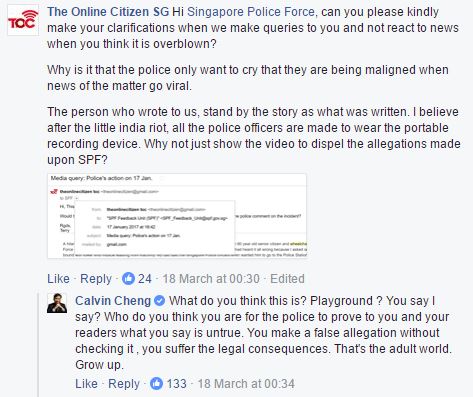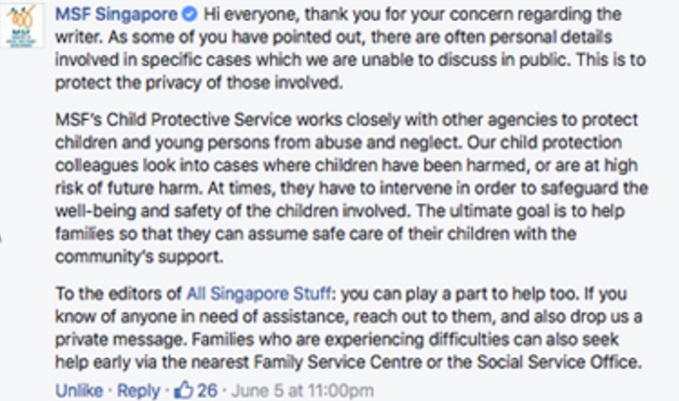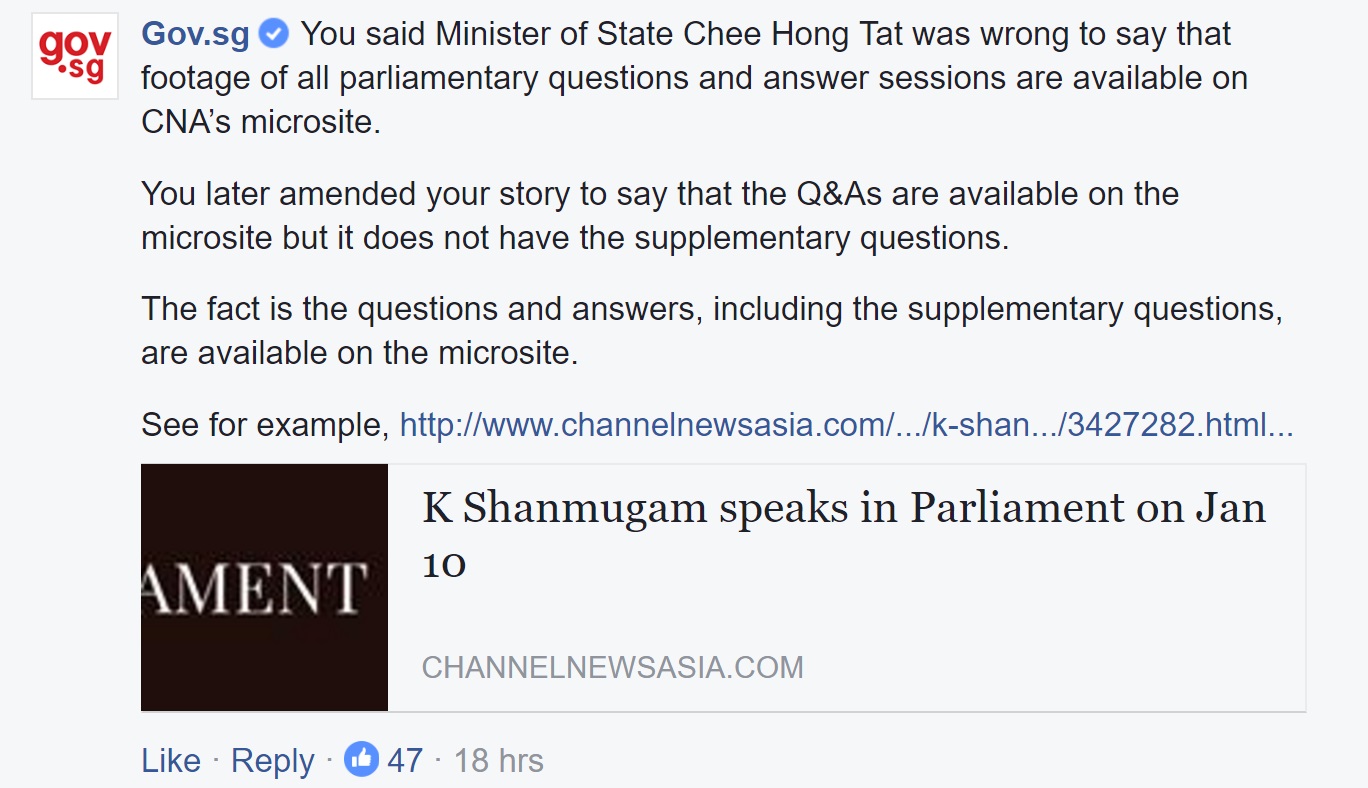Law and Home Affairs Minister K Shanmugam came out strongly in Parliament on Monday (Apr 3) against websites that peddled fake news. He named All Singapore Stuff and States Times Review (STR) as prime offenders.
The motivations for spreading fake news, according to him, are two-fold: To make money and destabilise a society.
In response to a separate Parliament question on false allegations made against the police, the minister said that socio-political website The Online Citizen (TOC) "in particular glorifies in running the Police down with a series of untrue stories."
He highlighted the recent report by TOC that alleged that the police had investigated an 80-year-old wheelchair-bound man for motorcycle theft -- this according to the police was false.
On the question of what actions the police can take against such allegations, Shanmugam said that the authorities was "considering the adequacy of our laws to ensure sufficient protection against unfounded attacks on the reputation and integrity of public institutions."
Anatomy of the wheelchair-bound "fake news" that arose on TOC
TOC received a letter from a "Ms Choo", relating how police officers on Jan 17 had supposedly accused her wheelchair-bound father of stealing a motorcycle.
TOC had published Choo's account of things in full which included her lambasting the police for a "ludicrous situation in that the Police officers were blind to assess a simple situation that could accumulate to a harassment charge on a senior citizen." The article was shared over 150 times.
In response, the Singapore Police Force posted an update on its Facebook page titled "False allegations against police published by The Online Citizen".
SPF said that the allegations were unfounded and the wheelchair-bound man was "never accused of being involved in any motor vehicle theft, nor was he asked to provide a statement at the Police station."
It added that it "will also not hesitate to take action against persons who deliberately make false allegations."
TOC subsequently posted a comment on SPF's Facebook page:

And again on a separate TOC article which stated that TOC had in fact reached out to SPF for comments on Choo's account of things on Jan 17, but SPF did not provide any response in the two months between the query and publication of TOC's article.
"Fake news" that could have been prevented?
This was not TOC's first time being accused of publishing false account of things.
It had earlier published accounts by an inventor, Ting Choon Meng, who accused Mindef of stealing his designs and sued them for it, and subsequently lost the patent case to Mindef.
TOC's coverage of Ting's story and a video interview of Ting prompted Mindef take out a court order against Ting and TOC under the Protection from Harassment Act (POHA). TOC was then required by the court to declare in its video and article that certain statements made by Ting have been declared by the courts to be false.
Could all this have been prevented if Mindef reached out to TOC to make clarifications?
Mindef responded to the issue on its own platforms here and here. However, it did not explicitly name TOC as the source of the "false allegations".
In the spirit of stemming fake news, did the way Mindef and SPF respond to TOC actually help perpetuate fake news instead?
Both did not engage TOC directly and instead posted refuting statements on their own platforms. This could be problematic especially for people who read TOC but do not follow Mindef/SPF's Facebook page. Those readers would still only have one side of the story. While Singaporeans should be discerning about what they read and try to read from multiple sources, it wouldn't hurt for government communications professionals to actually, well, manage communications and make things easier for Singaporeans.
Had both agencies engaged TOC earlier, perhaps the way both news stories would have turned out differently. Or at least TOC could carry Mindef/SPF's statement to provide a different side to the story. SPF's statement that the wheelchair-bound man was "never accused of being involved in any motor vehicle theft, nor was he asked to provide a statement at the Police station" could have directly refuted Choo's account of things had it been supplied to TOC directly.
Could it be an issue of trust?
Public agencies tend to shy away from non-mainstream media websites because some websites have agendas that are out of step with the government's.
But stonewalling a website like TOC, a platform that is run by Singaporeans and not anonymous foreigners, has only led to one conclusion -- "fake news" that could have been prevented with a little engagement.
Afterall, TOC has a corporate entity that is regulated by the Infocomm Media Development Authority (IMDA) under the Broadcasting (Class Licence) Notification.
Will the Government change its stance?
Actually, some progress has already been made on this front.
Both the Ministry of Social and Family Development (MSF) and Gov.sg have commented directly on Facebook posts of All Singapore Stuff and TOC respectively when facts were inaccurate:


Here's how TOC responded to Gov.sg's correction:
 Not exactly the ideal response that the government wanted but at least falsehoods were averted this case, no?
Not exactly the ideal response that the government wanted but at least falsehoods were averted this case, no?
It is understandable that the authorities would rather not respond to websites that may be "troublesome" and ask questions which some times the government has no immediate solutions to, but is legislating away the problem really the solution?
In Shanmugam's speech on fake news, he raised the example of the childcare centre in River Valley which was impacted because of a hoax photo-post circulating online alleging that it made children sleep on the floor and eat rotten fruit.
Channel 8 News was one of the first local media to break the news of the alleged abuse. It had visited the childcare centre on Feb 16 and had asked someone from the centre for comment, but they declined to do so. The centre only officially commented on Feb 22 refuting those claims, but by then news of what allegedly happened at the childcare centre was already widespread.
Should the media have held back on publishing the story because the childcare centre did not want to give comment? But what if the allegations turned out to be true and in the time it took to squeeze a comment out of the childcare centre, more abuse was committed? The line between reporting in the name of public interest and perpetuating falsehoods can be blurred at times.
The review of fake news is a good opportunity to re-engage the key information purveyors in Singapore
Shanmugam said the Government was "seriously considering" how to address the problem of fake news and will announce its position upon completion of a review.
Perhaps one of the real reasons why the Government needs to enact some form of legislation is the potential foreign risks fake news posed, rather than the domestic risks.
For instance, the STR is published by someone living outside Singapore.
More importantly, legislation may be required to swiftly address the type of foreign risks posed by world powers that treat Singapore as a pawn in their geo-political chess-game.
Hence, such a review is a good opportunity to reach out to the key information purveyors, both mainstream and alternative, online and offline.
Will the review introduce the possibility that public agencies respond directly to websites like TOC? Will the review also acknowledge that in some situations, as is the case for the childcare centre, falsehoods can some times be perpetuated by poor media and communications management?
Like how the government and Workers' Party (WP) were in agreement on Singapore's pragmatic foreign policy as a small city-state, "this unity of purpose" must be forged by the government with the key information purveyors.
This is because, like the political parties, the websites' lodestar should point towards Singaporean readers.
If you like what you read, follow us on Facebook and Twitter to get the latest updates.
If you like what you read, follow us on Facebook, Instagram, Twitter and Telegram to get the latest updates.
